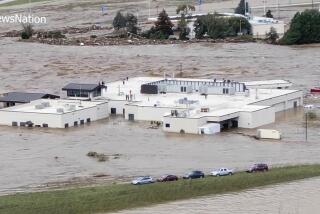Carbide Lays Leak to Human, Machine Errors
- Share via
WASHINGTON — A chain of human oversights and mechanical errors involving 31 employees helped spawn a cloud of toxic methylene chloride and 22 other chemicals that escaped from Union Carbide Corp.’s Institute, W. Va., plant on Aug. 11, sickening 135 persons, an internal company analysis of the accident concluded Friday.
In a Charleston, W. Va., news conference, company executives pledged to spend $50 million to “construct and rearrange operations” to lessen the odds that similar chemical accidents would occur at any of the firm’s plants around the world. They repeated their contention that the Institute gas cloud would have no lasting ill effects on the town’s 3,100 residents--some of whom have filed suits against Union Carbide that so far total $92 million.
Cyanide Released
However, among other chemicals that the firm now says were vented are a highly poisonous cyanide gas and a second chemical that, like methylene chloride, causes cancer in animals.
The company’s explanation of the accident basically added details to earlier accounts by state and federal officials, who blamed the incident on broken plant equipment and sloppy or inattentive plant workers.
According to Institute plant manager Hank Karawan and others, a 2-to-1 mixture of methylene chloride and aldicarb oxime was temporarily placed in an “oxidation reactor”--a tank used for chemical reactions--after a broken meter caused a nearby tank to be overfilled.
The liquids remained in the tank from Aug. 1 to Aug. 7, during which time a steam “jacket” apparently was turned on accidentally and began to heat the tank’s contents. On Aug. 7, workers pumped most of the mixture back to a reactor that produces the pesticide Temik. They stopped when the pump shut off but left about 500 gallons, or 4,000 pounds, of chemicals in the tank.
That mixture continued to boil away for four more days, creating a “self-sustaining” reaction that decomposed the aldicarb oxime and caused the remaining methylene chloride liquid to turn into a gas. The rising gas pressure finally burst out of the tank, triggering the leak.
Safety Rules Violated
In what officials called an obvious violation of safety guidelines, 31 workers responsible for the tank--a department head, five production engineers, five foremen and 20 line workers--failed during the entire period to check whether the reactor tank held any chemicals or was being heated.
“We have a standard operating procedure,” Karawan said. “We have a pre-start-up review. That was not done.”
“It’s obviously a combination of equipment failure and management practice,” said Robert D. Kennedy, president of Carbide’s chemicals and plastics division.
In releasing what they called a detailed study of the reactor tank that ruptured on Aug. 11, Union Carbide spokesmen said that methylene chloride was the largest single component of the gas cloud, accounting for about a fifth of the 3,800 pounds of chemicals that escaped. The Environmental Protection Agency last week estimated that the cloud was roughly two-thirds methylene chloride, but Union Carbide’s analysis said that some of the chemical boiled off and was vented before the leak occurred.
Little Aldicarb Released
Only about eight pounds were aldicarb oxime, the pesticide component that Union Carbide executives originally fingered as the culprit in the leak. Most of the chemicals that escaped, the company stated, were “decomposition products” created by the heating of aldicarb oxime in the reactor tank.
Of the 22 chemicals that the company now says composed the rest of the gas cloud, about 13% was isobutyronitrile, a gaseous cyanide that is fatal in large doses and causes dizziness, vomiting and rapid breathing in smaller doses. An additional 9% was dimethyl disulfide, a respiratory and skin irritant that is rated hazardous on Union Carbide’s internal guidelines for chemical toxicity.
Cloud Included Carcinogen
About 7% of the cloud was methyl mercaptan, a nervous system depressant regulated as a hazardous chemical by federal job-safety officials. And roughly 2% was dimethyl sulfide, an animal carcinogen that also causes respiratory, liver and kidney damage in large doses.
Jackson B. Browning, Union Carbide’s vice president for health affairs, said that there “is no reason to expect that the exposures to other materials contained in the release would have any adverse health effects.”
The EPA, which will complete its own investigation into the cause and contents of the leak in mid-September, refused to comment on the Union Carbide report.
More to Read
Inside the business of entertainment
The Wide Shot brings you news, analysis and insights on everything from streaming wars to production — and what it all means for the future.
You may occasionally receive promotional content from the Los Angeles Times.










